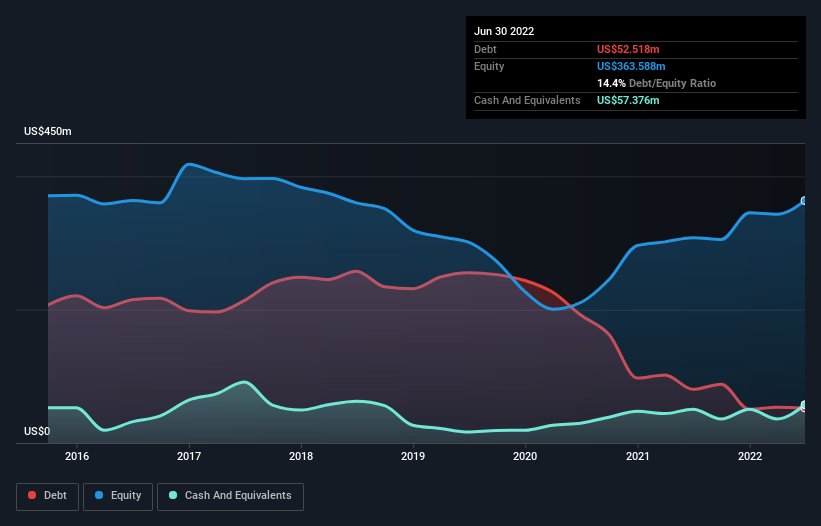- United States
- /
- Chemicals
- /
- NasdaqCM:ALTO
Alto Ingredients (NASDAQ:ALTO) Seems To Use Debt Quite Sensibly
David Iben put it well when he said, 'Volatility is not a risk we care about. What we care about is avoiding the permanent loss of capital.' So it seems the smart money knows that debt - which is usually involved in bankruptcies - is a very important factor, when you assess how risky a company is. We note that Alto Ingredients, Inc. (NASDAQ:ALTO) does have debt on its balance sheet. But should shareholders be worried about its use of debt?
What Risk Does Debt Bring?
Debt assists a business until the business has trouble paying it off, either with new capital or with free cash flow. If things get really bad, the lenders can take control of the business. However, a more usual (but still expensive) situation is where a company must dilute shareholders at a cheap share price simply to get debt under control. Of course, plenty of companies use debt to fund growth, without any negative consequences. When we examine debt levels, we first consider both cash and debt levels, together.
View our latest analysis for Alto Ingredients
What Is Alto Ingredients's Debt?
The image below, which you can click on for greater detail, shows that Alto Ingredients had debt of US$52.5m at the end of June 2022, a reduction from US$80.5m over a year. But it also has US$57.4m in cash to offset that, meaning it has US$4.86m net cash.

How Strong Is Alto Ingredients' Balance Sheet?
The latest balance sheet data shows that Alto Ingredients had liabilities of US$95.1m due within a year, and liabilities of US$72.6m falling due after that. On the other hand, it had cash of US$57.4m and US$92.7m worth of receivables due within a year. So its liabilities total US$17.6m more than the combination of its cash and short-term receivables.
Of course, Alto Ingredients has a market capitalization of US$317.9m, so these liabilities are probably manageable. Having said that, it's clear that we should continue to monitor its balance sheet, lest it change for the worse. While it does have liabilities worth noting, Alto Ingredients also has more cash than debt, so we're pretty confident it can manage its debt safely.
It is just as well that Alto Ingredients's load is not too heavy, because its EBIT was down 38% over the last year. When a company sees its earnings tank, it can sometimes find its relationships with its lenders turn sour. The balance sheet is clearly the area to focus on when you are analysing debt. But it is future earnings, more than anything, that will determine Alto Ingredients's ability to maintain a healthy balance sheet going forward. So if you want to see what the professionals think, you might find this free report on analyst profit forecasts to be interesting.
Finally, a company can only pay off debt with cold hard cash, not accounting profits. While Alto Ingredients has net cash on its balance sheet, it's still worth taking a look at its ability to convert earnings before interest and tax (EBIT) to free cash flow, to help us understand how quickly it is building (or eroding) that cash balance. During the last two years, Alto Ingredients produced sturdy free cash flow equating to 74% of its EBIT, about what we'd expect. This cold hard cash means it can reduce its debt when it wants to.
Summing Up
We could understand if investors are concerned about Alto Ingredients's liabilities, but we can be reassured by the fact it has has net cash of US$4.86m. The cherry on top was that in converted 74% of that EBIT to free cash flow, bringing in US$22m. So we are not troubled with Alto Ingredients's debt use. The balance sheet is clearly the area to focus on when you are analysing debt. However, not all investment risk resides within the balance sheet - far from it. We've identified 2 warning signs with Alto Ingredients (at least 1 which shouldn't be ignored) , and understanding them should be part of your investment process.
If, after all that, you're more interested in a fast growing company with a rock-solid balance sheet, then check out our list of net cash growth stocks without delay.
New: Manage All Your Stock Portfolios in One Place
We've created the ultimate portfolio companion for stock investors, and it's free.
• Connect an unlimited number of Portfolios and see your total in one currency
• Be alerted to new Warning Signs or Risks via email or mobile
• Track the Fair Value of your stocks
Have feedback on this article? Concerned about the content? Get in touch with us directly. Alternatively, email editorial-team (at) simplywallst.com.
This article by Simply Wall St is general in nature. We provide commentary based on historical data and analyst forecasts only using an unbiased methodology and our articles are not intended to be financial advice. It does not constitute a recommendation to buy or sell any stock, and does not take account of your objectives, or your financial situation. We aim to bring you long-term focused analysis driven by fundamental data. Note that our analysis may not factor in the latest price-sensitive company announcements or qualitative material. Simply Wall St has no position in any stocks mentioned.
About NasdaqCM:ALTO
Alto Ingredients
Produces, distributes, and markets specialty alcohols, renewable fuel, and essential ingredients in the United States.
Excellent balance sheet and fair value.
Similar Companies
Market Insights
Community Narratives



